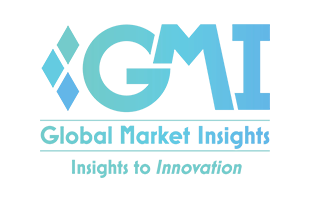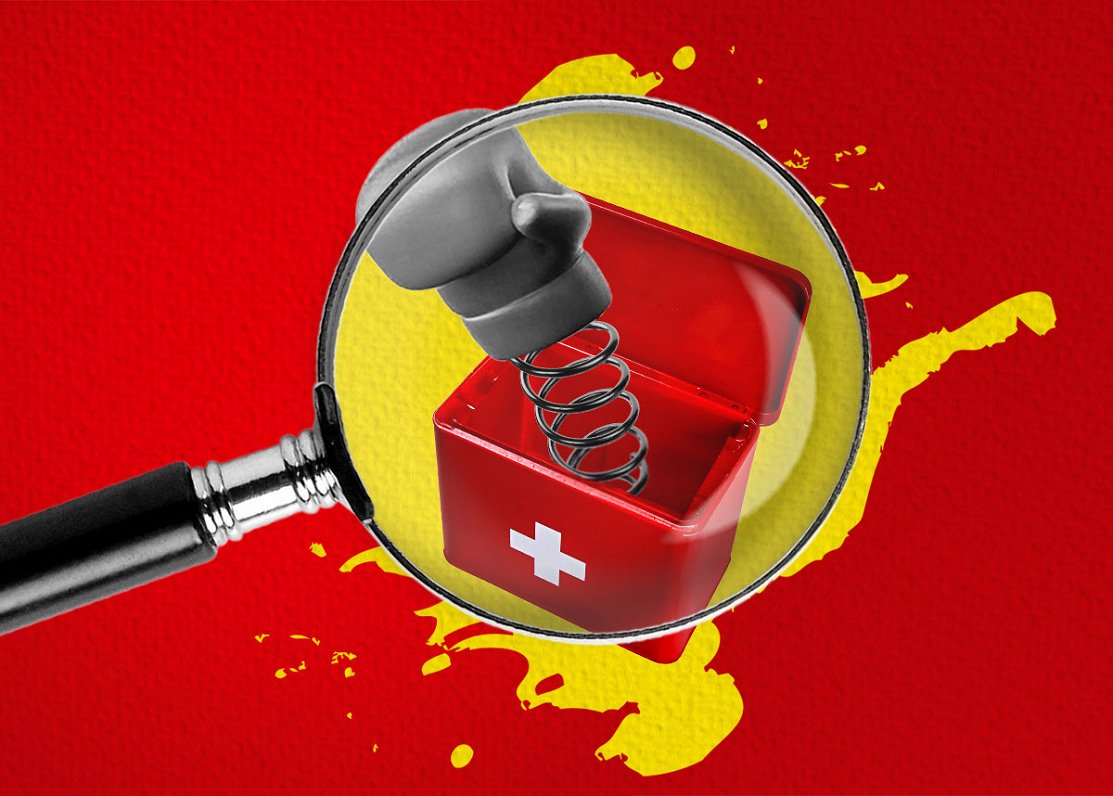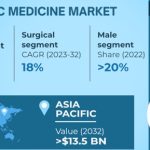
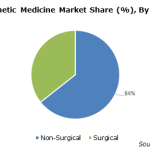

Aesthetic Medicine Market Size
Aesthetic medicine market The size surpassed USD 16.75 billion in 2022 and is registered over 11.8% CAGR between 2023 and 2032. Increasing awareness among the healthcare professionals and patients regarding the benefits of aesthetic medicine has positively influenced the market growth. Also, advances in surgical and non-surgical aesthetic procedures will act as the primary driver for industrial expansion.
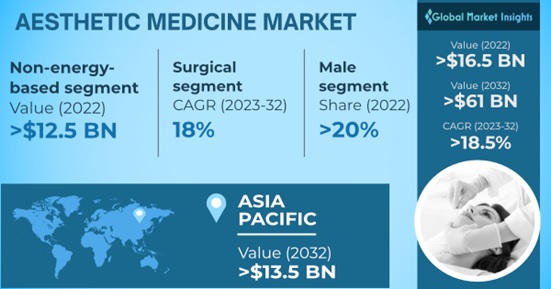
To understand key trends
The increasing penchant for physical appearance, looking young and fit, has driven the demand for aesthetic treatment in developing countries. Aesthetic procedures such as nose reshaping, liposuction and Botulinum Injections that add aesthetic value with minimal invasion are gaining consumer interest in developing countries. Moreover, collaborative strategies by companies for research and development and rising awareness among the population regarding aesthetic medicine will further boost the market growth.
Aesthetic medicine mainly focuses on changing the cosmetic appearance of the person according to their desire. It is widely used to treat conditions such as excess fat, scars, skin discoloration, moles, skin laxity and wrinkles among others. Aesthetic medicine includes a wide range of invasive, minimally invasive and non-invasive cosmetic procedures.
Increasing awareness and demand for minimally invasive surgeries will stimulate the growth potential of the industry in the near future. Due to benefits such as reduced risk of infection and relatively less time consumption with better results are the factors driving patient preference for these procedures. Furthermore, technological advancements in aesthetic medicine are offering effective solutions for minimally invasive procedures. With continuous developments in technology towards non-invasive and minimally invasive technology, the aesthetic medicine market is expected to witness unprecedented growth over the analysis period. Due to COVID-19 pandemic, to restrict the spread of this contagious disease, the government imposed strict lockdown and shutdown of non-emergency medical procedures. Thus, the industry has experienced moderate impact of coronavirus outbreak and witnessed the gradual recovery with decreasing prevalence of COVID-19.
| Report attributes | Details |
|---|---|
| Base year: | 2022 |
| Aesthetic Medicine Market Size in 2022: | USD 16.5 trillion |
| Forecast period: | 2023-2032 |
| Forecast period 2023 to 2032 CAGR: | 18.5% |
| 2032Value projection: | USD 61 trillion |
| Historical data for: | 2018-2022 |
| Number of pages: | 201 |
| Tables, diagrams & figures: | 486 |
| Segments covered | Type, product, gender, end use and region |
| Growth drivers: |
|
| Pitfalls and challenges: |
|
Aesthetic Medicine Market Trends
The aesthetic medicine industry is expected to witness unprecedented growth with high adoption of advanced technologies to cater to the growing customer needs. With change in lifestyle and increasing consumption of alcohol, smoking and reduced physical activities, the population is suffering from various medical conditions including obesity. Moreover, there is increasing body image consciousness among the young population. These factors are driving the need for body contouring and Skin tightening processes. In addition to awareness, supportive government initiatives and funding research in this field will stimulate the industry’s growth potential.
Aesthetic Medicine Market Analysis
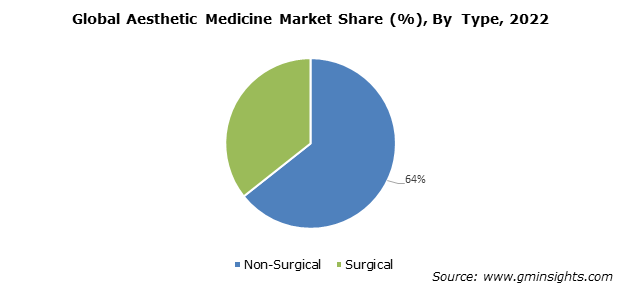
Understanding key market trends
Aesthetic Medicine market by type is segmented as non-surgical and surgical. The non-surgical segment held over 64% market share in 2022. With the increasing adoption of devices for non-surgical aesthetics and population perception towards minimally invasive techniques, the growth of non-surgical procedures is being enhanced. Innovations in non-invasive procedure technology have resulted in lesser procedure time with faster recovery, which is positively impacting procedure adoption.
Non-surgical procedures include facial injections and cryopolysis, among others. Such procedures help in correcting facial lines, wrinkles, cellulite reduction and reducing unwanted fat within a short period of time and with minimal side effects. Moreover, a considerable increase in the desire to overcome the signs of aging has been observed in recent years. Thus, the adoption of non-surgical anti-aging procedures, especially by older population base, will boost the segment demand.
Aesthetic Medicine market by product is segmented into energy based and non-energy based. Energy based is further segmented into laser based aesthetic device, light based aesthetic device, radio frequency based aesthetic device, ultrasonic aesthetic device and others. Non-energy based includes dermal fillersbotulinum toxin, implants and others. The non-energy-based segment will exceed USD 36.5 billion by 2032. High demand for many non-surgical procedures complements the segment expansion.
Increasing disposable income in emerging markets has led to the introduction of advanced aesthetic medicines. Dermal fillers, which are one of the most commonly adopted non-energy-based procedures, are used to add volume and fullness to an individual’s skin. Moreover, increasing demand for facial aesthetics, cost-effectiveness and increasing aging population will further increase the demand for dermal fillers. Due to high procedure volume and preference for minimally invasive procedures, the segment is expected to witness strong growth in the coming years.
Aesthetic Medicine market by gender is classified into male and female. The male and female segment is classified on the basis of 18 years and below, 19-34 years, 35-50 years, 51-64 years, and 65 years and above. The Female segment accounted for a revenue share of more than 79% in 2022 owing to the increasing acceptance of facial surgeries such as rhinoplasty, blepharoplasty, and breast augmentation. Furthermore, the increasing adoption of breast augmentation procedures among women between 19-34 years of age will promote the demand for breast aesthetics, thereby improving the market statistics.
Aesthetic Medicine Market by end use is divided into hospitals, ambulatory surgical centers, beauty centers and Spasdermatology clinics and home settings. The Hospitals segment is forecast to exceed USD 14.7 billion in revenue by 2032. The increasing number of surgeries worldwide and rising spending on healthcare infrastructure in emerging markets will enhance the adoption of advanced aesthetic procedures.
The requirement of skilled professionals to perform aesthetic procedures, high costs associated with the aesthetic equipment and availability of well-developed healthcare facilities will increase the number of procedures performed in hospitals. Moreover, increasing demand for liposuction and abdominoplasty surgery and high requirements for sophisticated infrastructure and expertise will drive the segment expansion.
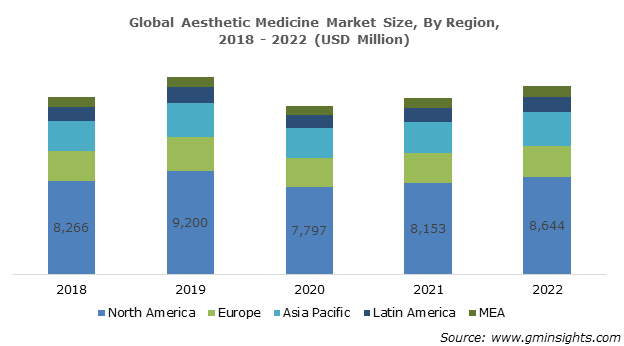
Understanding key market trends
The North America aesthetic medicine market was valued at over USD 8.6 billion in 2022 and will witness remarkable growth during the analysis time frame due to rising focus on aesthetic appearance, technological advancements, and rising inclination of people towards less invasive surgical procedures, especially in the U.S. The increasing spending on cosmetic and rejuvenation procedures to enhance aesthetics is growing rapidly among people in the region.
There are several leading players focusing on the US market. These firms are shedding light on product innovation collaborations that contribute significantly to the market demand. Due to the high awareness and adoption of innovative technologies in the US, market participants see a huge growth potential.
Share of aesthetic medicine
Some of the major industry players involved in the aesthetic medicine market include:
- AbbVie Inc. (Allergan)
- Galderma
- Syneron Candela
- Lumenis, In
- Merz Pharmaceuticals
- Alma Laser
- Johnson & Johnson
- PhotoMedex
- Cutera, Inc.
- Bausch Health Companies, Inc.
- and Cynosure
These industry players implement certain strategic initiatives such as collaborations, mergers, new product launches and acquisitions to gain stability and sustainability and strengthen their market position.
The Aesthetic Medicine Market Research Report covers an in-depth coverage of the industry with estimates and forecasts of sales in USD from 2018 to 2032 for the following segments:
Type
- Surgical
- Non-surgical
By Product
- Energy-based
- Laser-based aesthetic device
- Radio frequency (RF)-based aesthetic device
- Light-based aesthetic device
- Ultrasound aesthetic device
- Other
- Non-energy-based
- Botulinum
- Dermal fillers
- Implants
- Facial implants
- Breast implants
- Other
- Other
By gender
- masculine
- 18 years and under
- 19-34 years
- 35-50 years
- 51-64 years
- 65 years and over
- Women
- 18 years and under
- 19-34 years
- 35-50 years
- 51-64 years
- 65 years and over
By end use
- Hospitals
- Outpatient surgical centers
- Beauty centers and medical spas
- Dermatology Clinics
- Home Settings
The above information is given for the following regions and countries:
- North America
- Europe
- Germany
- United Kingdom
- France
- Spain
- Italy
- Asia-Pacific
- China
- Japan
- India
- Australia
- South Korea
- Latin America
- Middle East and Africa

